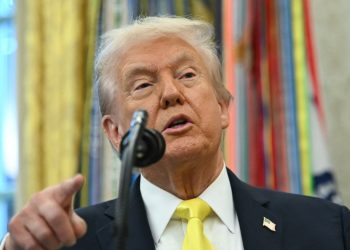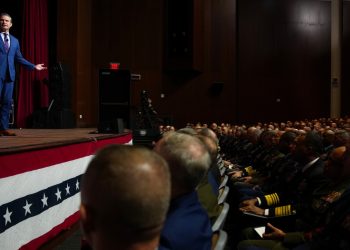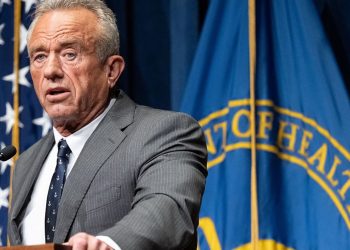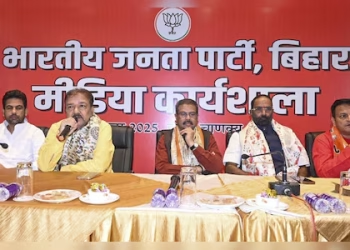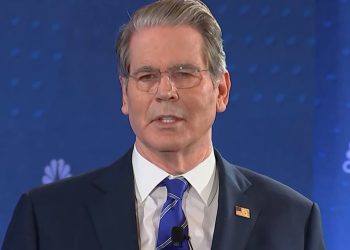U.S. Supreme Court police direct visitors behind security barriers outside the court building in Washington, DC, on the first day of the court’s new term, October 6.
Claire Harbage/NPR
hide caption
toggle caption
Claire Harbage/NPR
In 1965, President Lyndon Johnson signed the historic Voting Rights Act, declaring that “today is as enormous a triumph for liberty as any victory ever won on any battlefield.”
But over the past 12 years, the increasingly conservative Supreme Court has gutted the law, leaving only one major provision in place. Today, this provision also risks being annulled.
Section 2 of the Voting Rights Act is intended to ensure that minority voters are not excluded from the process of drawing new congressional districts.
When the law was passed in 1965, there were only six African-American, four Hispanic, and two Asian or Pacific Islander members in the House of Representatives. None of the representatives identified were from the Deep South.
This Congress began with 63 African American, 51 Hispanic, and 21 Asian or Pacific Islander representatives or delegates in the House.
Much of this change was driven by rules of the road under the Voting Rights Act.
However, all that could change if the court removes the redistricting guardrails it approved just two years ago. Indeed, if the Supreme Court strikes down Section 2 of the Voting Rights Act or makes it much more difficult to enforce, recent studies indicate that Democrats could lose as many as 19 congressional seats in the process, putting control of the House out of reach for the foreseeable future.

The specific issue in Wednesday’s case is a 5-4 Supreme Court ruling from just 28 months ago that upheld the Voting Rights Act’s framework for drawing new congressional district lines every 10 years.
This case involved Alabama, where the state refused to create a second majority African-American district until the court ordered it.
Wednesday’s case involves Louisiana and presents a nearly identical factual pattern. African-Americans make up about 30 percent of Louisiana’s voting population, but of the state’s six congressional districts, there is only one where they can and do consistently prevail in electing the candidate of their choice.
For years, the state Legislature fought to create a second district where minority voters could win. But after the Supreme Court’s decision in the Alabama case, the Louisiana legislature saw the legal writing on the wall and drew a new map creating a second district in which African-American voters would have a realistic chance of electing the candidate of their choice.
Normally, that would have been the end of the matter.

Neighborhood like “a snake”
But a group of 12 self-described “non-African American” voters stepped in to challenge the redistricting, calling it racist. And during the arguments last March, some conservative justices seemed to have an attack of buyer’s remorse.
A little more than two years ago, Chief Justice John Roberts wrote the court’s majority decision upholding the redistricting provision of the Voting Rights Act. But when the Louisiana redistricting case came up for debate last March, he seemed more than a little dubious.
“You think the layout of this neighborhood wasn’t primarily based on race?” » asked Roberts incredulously. “It’s a snake running from one end of the state to the other!”
Louisiana Solicitor General Benjamin Aguiñaga responded that the Supreme Court has long held that partisan gerrymandering is allowed, but racial gerrymandering is not. And here, he says, the motivation was explicitly partisan. The lines, he said, were drawn to create a second minority district and to protect three key incumbent Republicans in the House, including House Speaker Mike Johnson.
Pressed for further pressure, a frustrated Aguiñaga responded: “It’s an election year. We’re talking about the speaker of the House. No rational state is betting with such high stakes in this situation.”

Request for Reargument
Surprisingly, however, the judges did not decide the case at that time. Instead, on the last day of the term, they ordered re-argument in the case. Only this time, they added this question: Does the state’s intentional creation of a second majority-minority congressional district violate the 14th and 15th Amendments’ guarantee of voting rights and Congress’s authority to enforce that mandate?
To answer this question, Louisiana has now reversed its positions and, instead of defending the map drawn by its legislatures, it is arguing that the redistricting provision of the Voting Rights Act is unconstitutionally discriminatory.
“The case law continues to torment us,” said Louisiana Attorney General Elizabeth Murrill. She maintains that the court’s decision in Alabama “basically boils down to, well, if you’re engaging in corrective map drawing, you have to think about race, but you can’t think about it’s too much. That’s an impossible guideline.”
But Janai Nelson of the NAACP Legal Defense Fund will try to convince the justices that now is not the time to jettison the last truly effective provision of the Voting Rights Act.
If Section 2 were struck down, Nelson argued, “it would be totally devastating. It would allow racial gerrymandering with very few checks. But to be honest, as horrible and totally undemocratic as that outcome would be, what it would mean in terms of this court’s loyalty to what it once called the crown jewel of the civil rights movement.”

It is unclear why the court ordered a reargument in the case. There are a number of theories.
First, and most obvious, the fifth and decisive vote to uphold the provision two years ago was that of Justice Brett Kavanaugh. In a concurring opinion, he said at the time that there should be some time limit on the redistricting provision. And he may think the time has come.
A second possibility is that the court’s decision upholding the Voting Rights Act just two years ago was not as strong as it appeared. Indeed, court observers were surprised by the outcome, as Roberts has consistently opposed the Voting Rights Act in the past. And some speculated that Roberts and Kavanaugh, the two majority conservatives, were unwilling to rule against the voting law just weeks before the court struck down affirmative action in college admissions as unconstitutional.
A third possibility is that the court was simply unable to reach a majority agreement at the end of its term because it was bombarded by dozens of complaints filed by the Trump administration over the emergency docket.
Observers are watching what the court does this time.



